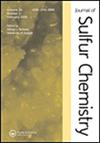由4-(4-吡啶基)噻唑-2-硫醇组装的含硫Cd(II)配位聚合物:合成、晶体结构、性质和Hirshfeld表面分析
IF 1.6
3区 化学
Q3 CHEMISTRY, MULTIDISCIPLINARY
引用次数: 0
摘要
4-(4-吡啶基)噻唑-2-硫醇(HPTT)分子是一种具有生物活性的含硫有机配体。本文合成了一种基于HPTT和硫氰酸钾(KSCN)的新型含硫配位聚合物{[Cd(PTT)(HPTT)(SCN)}n],并用理化方法对其进行了表征。单晶x射线衍射分析表明,化合物在单斜P21/n空间群中结晶,具有一维线结构。晶体结构通过分子内的C-H··N和C-H··S氢键以及分子间的N - h··N、C-H··π和π⋯π相互作用稳定,形成二维超分子层结构。用赫希菲尔德表面分析法对相互作用进行了分析。此外,该化合物在室温下表现出相对的热稳定性和固态光致发光。合成了一种以4-(4-吡啶基)噻唑-2-硫醇和硫氰酸钾为基料的新型含硫配位聚合物。单晶x射线衍射分析表明,化合物在单斜P21/n空间群中结晶,具有一维线结构。晶体结构通过氢键和π⋅⋅⋅π堆叠相互作用稳定,形成二维超分子层结构。用赫希菲尔德表面分析法对相互作用进行了分析。本文章由计算机程序翻译,如有差异,请以英文原文为准。
A sulfur-containing Cd(II) coordination polymer assembled from 4-(4-pyridinyl)thiazole-2-thiol: synthesis, crystal structure, properties, and Hirshfeld surface analysis
The 4-(4-pyridinyl)thiazole-2-thiol (HPTT) molecule with biological activities is a sulfur-containing organic ligand. Here, one new sulfur-containing coordination polymer based on HPTT and potassium thiocyanate (KSCN), namely, {[Cd(PTT)(HPTT)(SCN)}n, has been synthesized and characterized by physicochemical methods. The single-crystal X-ray diffraction analyses reveal the compound crystallizes in a monoclinic P21/n space group and features a one-dimensional line structure. The crystal structure is stabilized through intramolecular C–H···N and C–H···S hydrogen bonds and intermolecular N–H···N, C–H···π, and π⋯π interactions, generating a two-dimensional supramolecular layer structure. The interactions are also analyzed using Hirshfeld surface analysis. Moreover, the compound shows a relatively thermal stability and solid-state photoluminescence at room temperature.
One new sulfur-containing coordination polymer based on 4-(4-pyridinyl)thiazole-2-thiol and potassium thiocyanate has been synthesized and characterized. The single-crystal X-ray diffraction analyses reveal the compound crystallizes in a monoclinic P21/n space group and features a one-dimensional line structure. The crystal structure is stabilized by hydrogen bonds and π⋅⋅⋅π stacking interactions, generating a two-dimensional supramolecular layer structure. The interactions are also analyzed using Hirshfeld surface analysis.
求助全文
通过发布文献求助,成功后即可免费获取论文全文。
去求助
来源期刊

Journal of Sulfur Chemistry
CHEMISTRY, MULTIDISCIPLINARY-
CiteScore
4.10
自引率
9.10%
发文量
38
审稿时长
6-12 weeks
期刊介绍:
The Journal of Sulfur Chemistry is an international journal for the dissemination of scientific results in the rapidly expanding realm of sulfur chemistry. The journal publishes high quality reviews, full papers and communications in the following areas: organic and inorganic chemistry, industrial chemistry, materials and polymer chemistry, biological chemistry and interdisciplinary studies directly related to sulfur science.
Papers outlining theoretical, physical, mechanistic or synthetic studies pertaining to sulfur chemistry are welcome. Hence the target audience is made up of academic and industrial chemists with peripheral or focused interests in sulfur chemistry. Manuscripts that truly define the aims of the journal include, but are not limited to, those that offer: a) innovative use of sulfur reagents; b) new synthetic approaches to sulfur-containing biomolecules, materials or organic and organometallic compounds; c) theoretical and physical studies that facilitate the understanding of sulfur structure, bonding or reactivity; d) catalytic, selective, synthetically useful or noteworthy transformations of sulfur containing molecules; e) industrial applications of sulfur chemistry; f) unique sulfur atom or molecule involvement in interfacial phenomena; g) descriptions of solid phase or combinatorial methods involving sulfur containing substrates. Submissions pertaining to related atoms such as selenium and tellurium are also welcome. Articles offering routine heterocycle formation through established reactions of sulfur containing substrates are outside the scope of the journal.
 求助内容:
求助内容: 应助结果提醒方式:
应助结果提醒方式:


